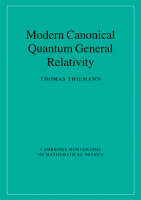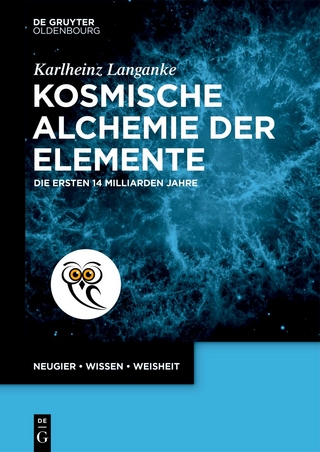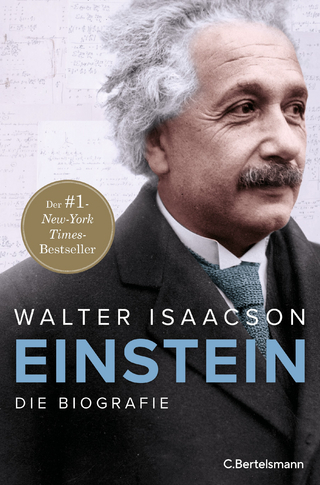
Modern Canonical Quantum General Relativity
Cambridge University Press (Verlag)
978-0-521-74187-3 (ISBN)
Modern physics rests on two fundamental building blocks: general relativity and quantum theory. General relativity is a geometric interpretation of gravity while quantum theory governs the microscopic behaviour of matter. Since matter is described by quantum theory which in turn couples to geometry, we need a quantum theory of gravity. In order to construct quantum gravity one must reformulate quantum theory on a background independent way. Modern Canonical Quantum General Relativity provides a complete treatise of the canonical quantisation of general relativity. The focus is on detailing the conceptual and mathematical framework, on describing physical applications and on summarising the status of this programme in its most popular incarnation, called loop quantum gravity. Mathematical concepts and their relevance to physics are provided within this book, which therefore can be read by graduate students with basic knowledge of quantum field theory or general relativity.
Thomas Thiemann is Staff Scientist at the Max Planck Institut für Gravitationsphysik (Albert Einstein Institut), Potsdam, Germany. He is also a long-term researcher at the Perimeter Institute for Theoretical Physics and Associate Professor at the University of Waterloo, Canada. Thomas Thiemann obtained his PhD in theoretical physics from the Rheinisch-Westfälisch Technische Hochschule, Aachen, Germany. He held two year postdoctoral positions at The Pennsylvania State University and Harvard University. As of 2005 he holds a guest professor position at Beijing Normal University, China.
Preface; Notation and conventions; Introduction; Part I. Classical Foundations, Interpretation and the Canonical Quantisation Programme: 1. Classical Hamiltonian formulation of general relativity; 2. The problem of time, locality and the interpretation of quantum mechanics; 3. The programme of canonical quantisation; 4. The new canonical variables of Ashtekar for general relativity; Part II. Foundations of Modern Canonical Quantum General Relativity: 5. Introduction; 6. Step I: the holonomy-flux algebra [P]; 7. Step II: quantum-algebra; 8. Step III: representation theory of [A]; 9. Step IV: 1. Implementation and solution of the kinematical constraints; 10. Step V: 2. Implementation and solution of the Hamiltonian constraint; 11. Step VI: semiclassical analysis; Part III. Physical Applications: 12. Extension to standard matter; 13. Kinematical geometrical operators; 14. Spin foam models; 15. Quantum black hole physics; 16. Applications to particle physics and quantum cosmology; 17. Loop quantum gravity phenomenology; Part IV. Mathematical Tools and their Connection to Physics: 18. Tools from general topology; 19. Differential, Riemannian, symplectic and complex geometry; 20. Semianalytical category; 21. Elements of fibre bundle theory; 22. Holonomies on non-trivial fibre bundles; 23. Geometric quantisation; 24. The Dirac algorithm for field theories with constraints; 25. Tools from measure theory; 26. Elementary introduction to Gel'fand theory for Abelean C* algebras; 27. Bohr compactification of the real line; 28. Operatir -algebras and spectral theorem; 29. Refined algebraic quantisation (RAQ) and direct integral decomposition (DID); 30. Basics of harmonic analysis on compact Lie groups; 31. Spin network functions for SU(2); 32. + Functional analytical description of classical connection dynamics; Bibliography; Index.
| Erscheint lt. Verlag | 13.11.2008 |
|---|---|
| Reihe/Serie | Cambridge Monographs on Mathematical Physics |
| Verlagsort | Cambridge |
| Sprache | englisch |
| Maße | 174 x 248 mm |
| Gewicht | 1410 g |
| Themenwelt | Naturwissenschaften ► Physik / Astronomie ► Astronomie / Astrophysik |
| Naturwissenschaften ► Physik / Astronomie ► Thermodynamik | |
| ISBN-10 | 0-521-74187-4 / 0521741874 |
| ISBN-13 | 978-0-521-74187-3 / 9780521741873 |
| Zustand | Neuware |
| Informationen gemäß Produktsicherheitsverordnung (GPSR) | |
| Haben Sie eine Frage zum Produkt? |
aus dem Bereich


